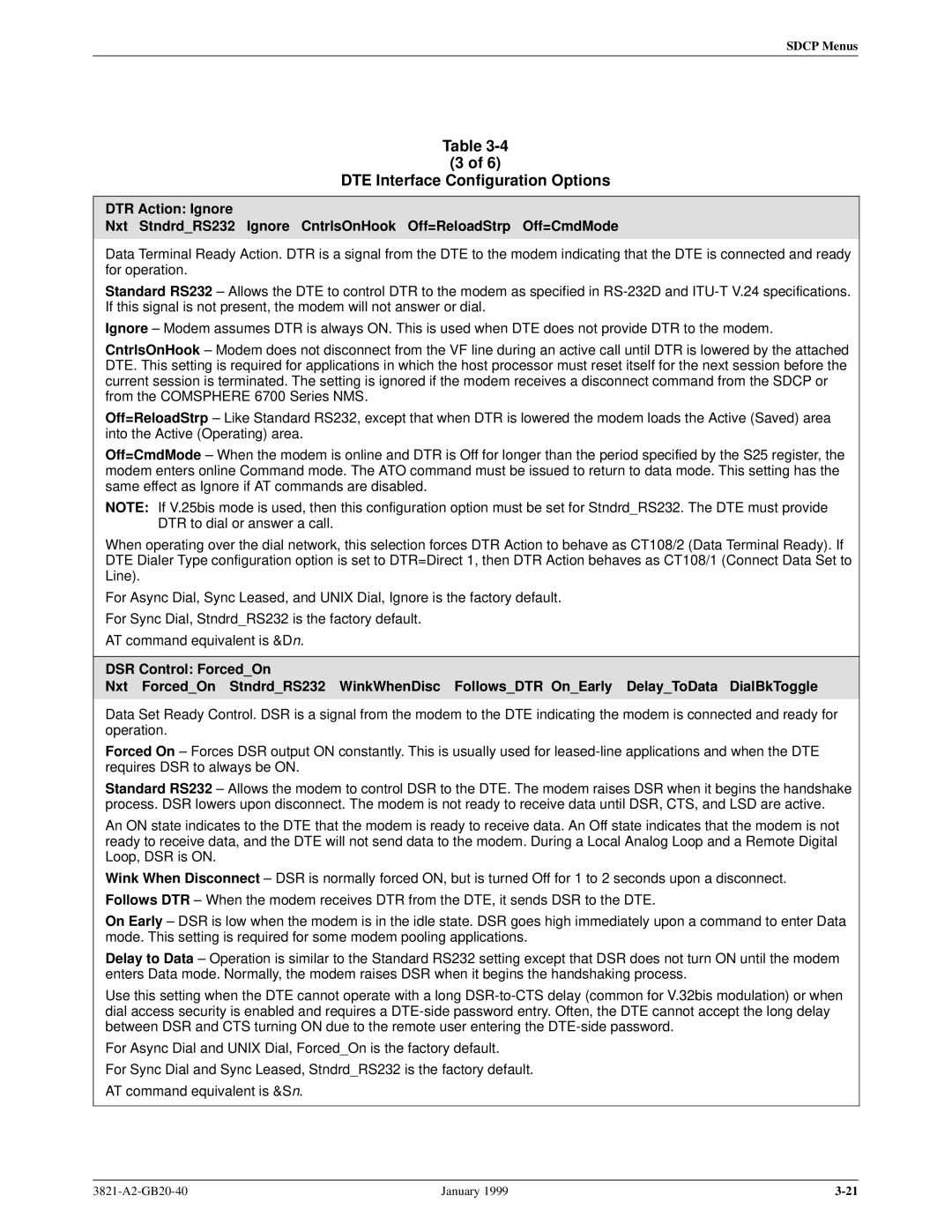
SDCP Menus
Table
(3 of 6)
DTE Interface Configuration Options
DTR Action: Ignore
Nxt Stndrd_RS232 Ignore CntrlsOnHook Off=ReloadStrp Off=CmdMode
Data Terminal Ready Action. DTR is a signal from the DTE to the modem indicating that the DTE is connected and ready for operation.
Standard RS232 ± Allows the DTE to control DTR to the modem as specified in
Ignore ± Modem assumes DTR is always ON. This is used when DTE does not provide DTR to the modem.
CntrlsOnHook ± Modem does not disconnect from the VF line during an active call until DTR is lowered by the attached DTE. This setting is required for applications in which the host processor must reset itself for the next session before the current session is terminated. The setting is ignored if the modem receives a disconnect command from the SDCP or from the COMSPHERE 6700 Series NMS.
Off=ReloadStrp ± Like Standard RS232, except that when DTR is lowered the modem loads the Active (Saved) area into the Active (Operating) area.
Off=CmdMode ± When the modem is online and DTR is Off for longer than the period specified by the S25 register, the modem enters online Command mode. The ATO command must be issued to return to data mode. This setting has the same effect as Ignore if AT commands are disabled.
NOTE: If V.25bis mode is used, then this configuration option must be set for Stndrd_RS232. The DTE must provide DTR to dial or answer a call.
When operating over the dial network, this selection forces DTR Action to behave as CT108/2 (Data Terminal Ready). If DTE Dialer Type configuration option is set to DTR=Direct 1, then DTR Action behaves as CT108/1 (Connect Data Set to Line).
For Async Dial, Sync Leased, and UNIX Dial, Ignore is the factory default.
For Sync Dial, Stndrd_RS232 is the factory default.
AT command equivalent is &Dn.
DSR Control: Forced_On
Nxt Forced_On Stndrd_RS232 WinkWhenDisc Follows_DTR On_Early Delay_ToData DialBkToggle
Data Set Ready Control. DSR is a signal from the modem to the DTE indicating the modem is connected and ready for operation.
Forced On ± Forces DSR output ON constantly. This is usually used for
Standard RS232 ± Allows the modem to control DSR to the DTE. The modem raises DSR when it begins the handshake process. DSR lowers upon disconnect. The modem is not ready to receive data until DSR, CTS, and LSD are active.
An ON state indicates to the DTE that the modem is ready to receive data. An Off state indicates that the modem is not ready to receive data, and the DTE will not send data to the modem. During a Local Analog Loop and a Remote Digital Loop, DSR is ON.
Wink When Disconnect ± DSR is normally forced ON, but is turned Off for 1 to 2 seconds upon a disconnect.
Follows DTR ± When the modem receives DTR from the DTE, it sends DSR to the DTE.
On Early ± DSR is low when the modem is in the idle state. DSR goes high immediately upon a command to enter Data mode. This setting is required for some modem pooling applications.
Delay to Data ± Operation is similar to the Standard RS232 setting except that DSR does not turn ON until the modem enters Data mode. Normally, the modem raises DSR when it begins the handshaking process.
Use this setting when the DTE cannot operate with a long
For Async Dial and UNIX Dial, Forced_On is the factory default.
For Sync Dial and Sync Leased, Stndrd_RS232 is the factory default.
AT command equivalent is &Sn.
January 1999 |
